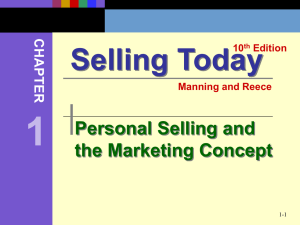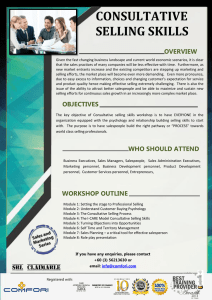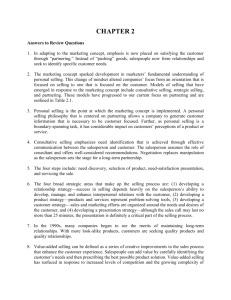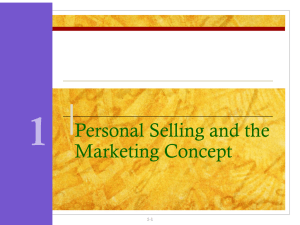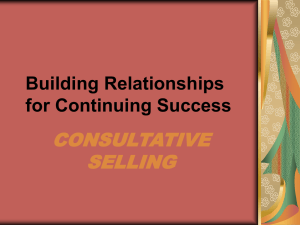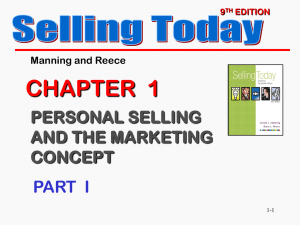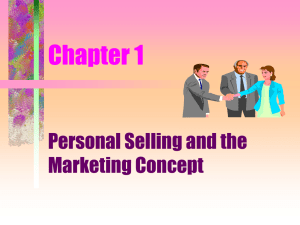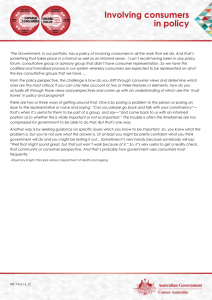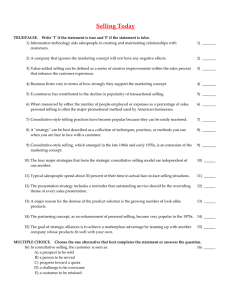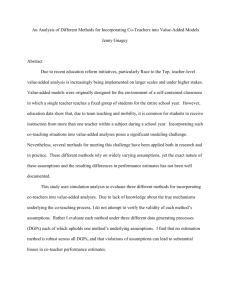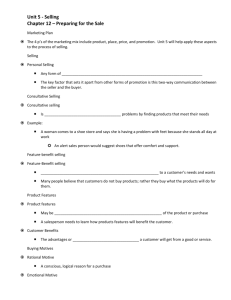Test Bank for Selling Today Creating Customer Value
advertisement
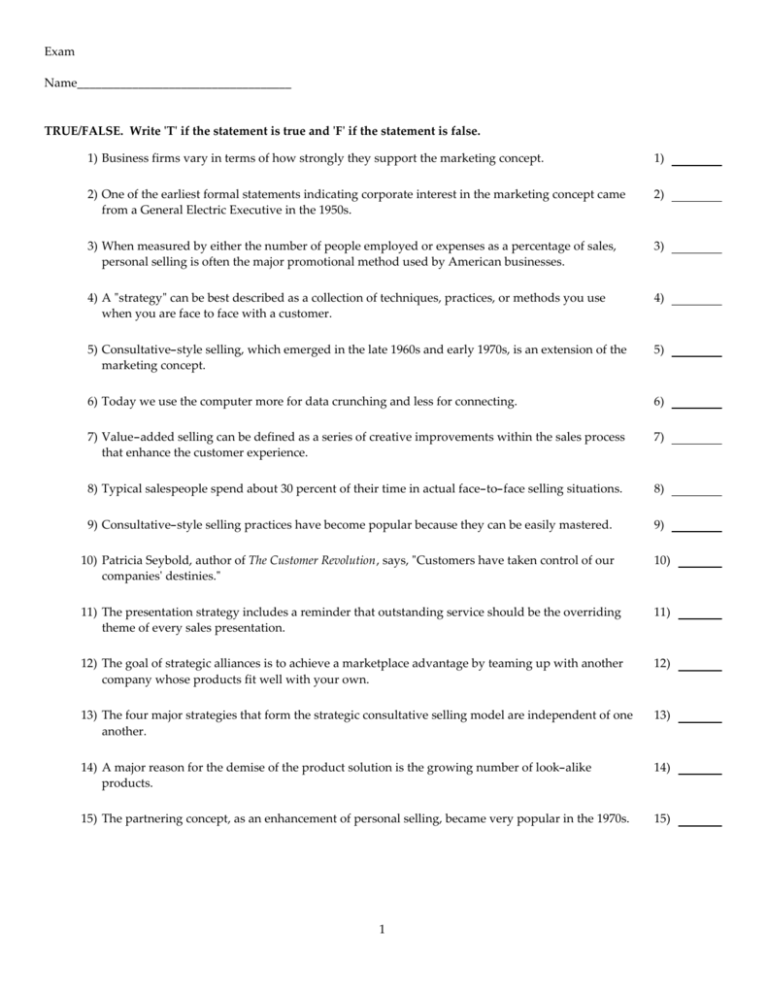
Exam Name___________________________________ TRUE/FALSE. Write ʹTʹ if the statement is true and ʹFʹ if the statement is false. 1) Business firms vary in terms of how strongly they support the marketing concept. 1) 2) One of the earliest formal statements indicating corporate interest in the marketing concept came from a General Electric Executive in the 1950s. 2) 3) When measured by either the number of people employed or expenses as a percentage of sales, personal selling is often the major promotional method used by American businesses. 3) 4) A ʺstrategyʺ can be best described as a collection of techniques, practices, or methods you use when you are face to face with a customer. 4) 5) Consultative-style selling, which emerged in the late 1960s and early 1970s, is an extension of the marketing concept. 5) 6) Today we use the computer more for data crunching and less for connecting. 6) 7) Value-added selling can be defined as a series of creative improvements within the sales process that enhance the customer experience. 7) 8) Typical salespeople spend about 30 percent of their time in actual face-to-face selling situations. 8) 9) Consultative-style selling practices have become popular because they can be easily mastered. 9) 10) Patricia Seybold, author of The Customer Revolution, says, ʺCustomers have taken control of our companiesʹ destinies.ʺ 10) 11) The presentation strategy includes a reminder that outstanding service should be the overriding theme of every sales presentation. 11) 12) The goal of strategic alliances is to achieve a marketplace advantage by teaming up with another company whose products fit well with your own. 12) 13) The four major strategies that form the strategic consultative selling model are independent of one another. 13) 14) A major reason for the demise of the product solution is the growing number of look-alike products. 14) 15) The partnering concept, as an enhancement of personal selling, became very popular in the 1970s. 15) 1 MULTIPLE CHOICE. Choose the one alternative that best completes the statement or answers the question. 16) All of the following are elements of the marketing mix except: A) personnel. B) place. C) promotion. 17) The ultimate goal of the ʺmarketing conceptʺ is: A) product diversification. C) rising profit margins. 16) D) product. 17) B) brand loyalty. D) customer satisfaction. 18) Eric Villa obtained a license to sell real estate and then accepted a sales position with a local Century 21 agency. To prepare for this new position, he purchased and read a research report entitled Buying Habits of Todayʹs Home Buyers. Mr. Villa is attempting to develop a: A) product strategy. B) relationship strategy. C) customer strategy. D) presentation strategy. 18) 19) When a marketer decides to adopt partnering, emphasis will be placed on: A) product development. B) the customer. C) selling strategies. D) selling tactics. 19) 20) The evolution of strategic selling can be traced to: A) the growing demand for less expensive products. B) the need for salespeople to master sales force automation practices. C) several trends that resulted in a more complex selling environment. D) new levels of competition. 20) 21) The term product should be broadly interpreted to encompass: A) information, services, ideas, and issues. B) all intangible items. C) tangible items and issues. D) all tangible items. 21) 22) The development of a personal selling philosophy involves all of the following EXCEPT: A) assuming the role of a problem-solver or partner in helping customers make complex buying decisions. B) a full acceptance of the marketing concept. C) developing an appreciation for the expanding role of personal selling in our competitive national and international markets. D) a full appreciation of the tenets of the free enterprise system. 22) 23) When UPS was first established, founder Jim Casey described the firmʹs focus as follows: A) To become a leader in international shipping. B) To render perfect service to our stores and their customers. C) To become the worldʹs most profitable company. D) To become the worldʹs most efficient shipping company. 23) 24) In a market characterized by vigorous competition, look-alike products and customer loyalty that depends on quality relationships, as well as quality products, the salesperson should fully utilize the: A) customer strategy. B) relationship strategy. C) presentation strategy. D) product strategy. 24) 2 25) The promotion element of a marketing program can be subdivided into the areas of: A) public relations, place, personal selling, and personnel. B) product research, product design, product production, and product publicity C) sales promotion, public relations, personal selling, and advertising. D) market research, personnel, and product publicity. 25) 26) Which of the following statements would NOT be an application of the marketing concept? A) Letʹs examine our points of distribution to see if weʹre reaching the market effectively. B) Letʹs do some research to see which colors the consumers prefer. C) Letʹs show these product designs to some prospective buyers for their reactions. D) Letʹs speed up production and get these products to customers faster by eliminating the field test. 26) 27) Which of the following statements accurately describes value-added selling? A) Value-added selling surfaced during the evolution of strategic selling. B) The value added by salespeople today is increasingly derived from tangibles. C) The value added by salespeople today is increasingly derived from intangibles. D) Value-added selling would not be an appropriate strategy in international markets. 27) 28) A major development that has helped the information economy is: A) recognition that customers want more information. B) major advances in information technology. C) new demands for improved customer service. D) the need for more strategic alliances. 28) 29) The four broad strategic areas of the Strategic/Consultative Selling Model are: A) relationship strategy, product strategy, customer strategy and presentation strategy. B) relationship strategy, company strategy, customer strategy, and credit strategy. C) relationship strategy, company strategy, product strategy, and service strategy. D) relationship strategy, customer strategy, product strategy, and service strategy. 29) 30) Sharon Wiley is a sales representative employed by a leading producer of pharmaceuticals used in veterinary medicine. Recently she attended a university-sponsored seminar that focused on new research findings in selected areas of veterinary medicine. Ms. Wiley is attempting to develop a: A) relationship strategy. B) customer strategy. C) presentation strategy. D) product strategy. 30) SHORT ANSWER. Write the word or phrase that best completes each statement or answers the question. 31) A ________ ________ is a well thought -out plan for establishing, building and maintaining quality selling relationships. 31) 32) ________ selling can be defined as a series of creative improvements within the sales process that enhance the customer experience. 32) 33) Peter Drucker stated that ʺthe ________ defines the business.ʺ 33) 34) ________ ________ evolved because of broader and more diverse product lines, demand for specific customized solutions, and more competition. 34) 3 35) A ________ ________ is a carefully conceived plan that will result in maximum responsiveness to customers. 35) 36) List the three prescriptions for developing a personal selling philosophy 36) 37) List and describe the five strategic steps of the Strategic Consultative Selling Model. 37) MATCHING. Choose the item in column 2 that best matches each item in column 1. For each descriptive phrase or statement, select the most appropriate answer from the items listed. 38) This term is used to describe a new form of partnership. A) value-added selling 38) B) marketing concept 39) This person said, ʺThe customer defines the business.ʺ 40) A more complex selling environment created the need for this enhancement of consultative selling,: 41) Moving from a production and engineering orientation to customer orientation: 42) Combining elements known as the four Pʹs, 43) A growing emphasis on relationships brought about this enhancement of consultative selling. 44) An extension of the marketing concept that emerged in the late 1960s and early 1970s, 39) C) transactional selling D) Peter Drucker 40) E) consultative selling F) strategic selling 41) G) marketing mix H) post-sale service I) partnering 42) 43) J) strategic alliance K) ACT 44) L) 1970s 45) A sales process that matches the needs of a customer who is primarily interested in price and convenience. 45) 46) Creative improvements in the sales process that enhance the customer experience, 46) 4 47) Strategic Selling Era begins, A) Marriott Hotels 48) Assume the role of problem-solver. B) part of oneʹs personal selling philosophy 49) Each of the 8,500 sales reps can sell the services of 10 brands in this companyʹs portfolio. C) early 1980s 5 47) 48) 49) Answer Key Testname: UNTITLED1 1) 2) 3) 4) 5) 6) 7) 8) 9) 10) 11) 12) 13) 14) 15) 16) 17) 18) 19) 20) 21) 22) 23) 24) 25) 26) 27) 28) 29) 30) 31) 32) 33) 34) 35) 36) 37) 38) 39) 40) 41) 42) TRUE TRUE TRUE FALSE TRUE FALSE TRUE TRUE FALSE TRUE TRUE TRUE FALSE TRUE FALSE A D C B C A D B B C D C B A D Relationship strategy Value-added customer Strategic selling Customer strategy Adopt marketing concept, value personal selling, and assume role of problem solver. 1. Developing a personal selling philosophy. This involves adopting the marketing concept, valuing personal selling and assuming the role of problem-solver. 2. Developing a relationship strategy. Success in selling depends heavily on the salespersonʹs ability to develop, manage, and enhance interpersonal relations with the customer. 3. Developing a product strategy. Products and services represent the problem-solving tools available to salespeople. 4. Developing a customer strategy. Sales and marketing efforts must be organized around the needs and desires of the customer. 5. Developing a presentation strategy. The presentation is a critical part of the selling process because it is at this point that the salesperson determines whether the customer has a need for the product. J D F B G 6 Answer Key Testname: UNTITLED1 43) 44) 45) 46) 47) 48) 49) I E C A C B A 7
